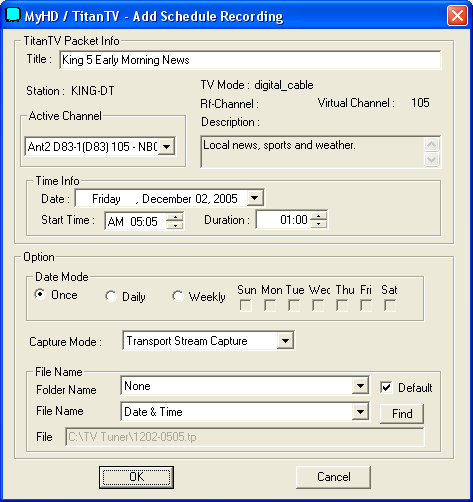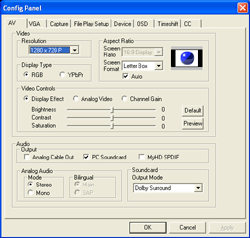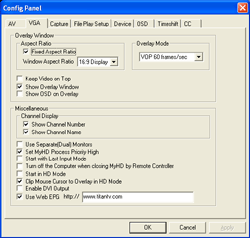HTPC - TV Tuner Reviews
by Jarred Walton on December 7, 2005 12:05 AM EST- Posted in
- Smartphones
- Mobile
More MyHD MDP-130
Once the card is properly configured, you can get around to actually using it. The setup is a bit tedious - both in waiting for the channel scan to complete as well as in properly configuring analog capture settings - but the card works well once configured.
The quality of the HD reception is great, and in the HD/bypass mode, it is impossible to tell the difference between the output of the Comcast box and the output of the MyHD card. Those with decent OTA DTV reception will find more to like with the MyHD. TitanTV works properly with no need to configure your channels manually, and you can even use antenna 1 for OTA HD and antenna 2 for analog/digital cable, with the card switching between the two inputs as necessary.
Speaking of TitanTV, MyHD includes a utility called "TitanTVHelperApp.exe" to allow you to schedule recordings within TitanTV. While it would be nice not to have to go through the training process, it's better than nothing. The way you "train" MyHD and TitanTV to work together is another somewhat complex interface. You have to select the "record" link within TitanTV, which brings up the top dialog shown above. You also need to know the virtual channel maps to the desired program. In the example image, NBC HD shows up as channel 105-1 in TitanTV, but the real channel is 83-1. Once you select the new channel and press OK, you're greeted with the MyHD update confirmation dialog (the lower image). If you choose "Yes," MyHD will remember your change for the future. Once this is done for each digital channel you want to watch, you can then forget about remembering sub-channels.
There are still some items to address, though. While watching digital channels works very well, the analog reception is clearly worse than the other two cards. Besides the performance issues, image quality at best is perhaps a tie or slightly better than the Fusion5, and clearly inferior to the Theater 550. Timeshifting (pause/play of live TV) works fine, but only for digital channels. Given the issues with recording analog channels, that's not too surprising, and the FusionHDTV software has the same problem. Still, people used to TiVo or the Windows MCE interface will find this to be a less-than-perfect solution, and unlike the other cards in this article, Windows MCE is not supported with the MyHD.
Something else that we felt was lacking was the overlay/preview window. This apparently shows 720x480 content, scaled to however large you make the window. We wish that an option for the full content was available, but even if the preview window only shows a 480p version of the content, the ability to simply maximize the overlay window would be a good addition. (Completely eliminating the overscan of the Toshiba HDTV is pretty cool and can be done with the FusionHDTV software, for example.) This is really a minor complaint, though.
Another slightly confusing interface issue comes up with the video output and aspect ratios. As mentioned before, the HDTV is a 1080i device. We have the computer set to output a 720p (actually 1152x648) signal, so that text remains legible in Windows. Switching to HD mode bypasses the PC output and goes straight from the MyHD card, so a separate output setting takes precedence (and unfortunately, we get overscan from the TV). There are quite a few resolutions available, but the most useful are 1920x1080i, 1280x720p, and Native. Since most HD broadcasts are in either 720p or 1080i, selecting "Native" seems like it should provide the optimal result. However, this actually causes all of the analog channels to end up stretched or zoomed, and sometimes the digital channels get skewed as well.
Selecting a specific widescreen resolution solves these problems, but this isn't immediately clear and you might also wonder how to proceed. The FusionHDTV software has an option for aspect ratio called "Original", and it works properly for all HD and analog channels. The "Native" AR in MyHD tries to accomplish that, but it doesn't work out as well (and you would end up with your TV often changing resolutions every time that you change the channel). The UI on the MyHD card has options for video resolution, screen ratio, and screen format on the AV page. We feel the best result comes from choosing a standard resolution for your display (1920x1080i or 1280x720p most likely), and then check the "Auto" box in the aspect ratio. It may not get every AR correct, but that's probably due to the lack of tight standards in the US market more than anything. You can also set up the overlay size on the VGA dialog tab, and we selected "Fixed Aspect Ratio" and "16:9 Display".
The MyHD card ends up being the reverse of the Fusion5. It has issues with analog video, but the digital quality is better (and uses fewer system resources) and there are few major bugs/problems. The card lists the minimum system requirements as a Pentium II 400 MHz, and while that might work for DTV content where the hardware decoding is a factor, watching and recording the analog channels requires an excessive amount of CPU power. Of course, most people are going to be interested in the HD aspects of this card, and the analog is only a fringe benefit.
With a fast system and once configured properly, the MyHD worked very well and didn't give us any cause for complaint. The cost is substantially higher, but right now, it would definitely be our pick out of these two HD-capable cards. It's better to spend an extra $100 for a device that works well more often than not than to save the money and end up fighting with a problematic interface. Considering the cost of equipment used in many entertainment centers, $270 for the MyHD + DVI really isn't that much - you can even throw in a dual core processor for $330 and you're still only up to the price of a good set of speakers, and nowhere near what some people pay for high-end speakers. If you enjoy checking out the latest home theater equipment, the MyHD card isn't likely to disappoint.
Once the card is properly configured, you can get around to actually using it. The setup is a bit tedious - both in waiting for the channel scan to complete as well as in properly configuring analog capture settings - but the card works well once configured.
The quality of the HD reception is great, and in the HD/bypass mode, it is impossible to tell the difference between the output of the Comcast box and the output of the MyHD card. Those with decent OTA DTV reception will find more to like with the MyHD. TitanTV works properly with no need to configure your channels manually, and you can even use antenna 1 for OTA HD and antenna 2 for analog/digital cable, with the card switching between the two inputs as necessary.


Speaking of TitanTV, MyHD includes a utility called "TitanTVHelperApp.exe" to allow you to schedule recordings within TitanTV. While it would be nice not to have to go through the training process, it's better than nothing. The way you "train" MyHD and TitanTV to work together is another somewhat complex interface. You have to select the "record" link within TitanTV, which brings up the top dialog shown above. You also need to know the virtual channel maps to the desired program. In the example image, NBC HD shows up as channel 105-1 in TitanTV, but the real channel is 83-1. Once you select the new channel and press OK, you're greeted with the MyHD update confirmation dialog (the lower image). If you choose "Yes," MyHD will remember your change for the future. Once this is done for each digital channel you want to watch, you can then forget about remembering sub-channels.
There are still some items to address, though. While watching digital channels works very well, the analog reception is clearly worse than the other two cards. Besides the performance issues, image quality at best is perhaps a tie or slightly better than the Fusion5, and clearly inferior to the Theater 550. Timeshifting (pause/play of live TV) works fine, but only for digital channels. Given the issues with recording analog channels, that's not too surprising, and the FusionHDTV software has the same problem. Still, people used to TiVo or the Windows MCE interface will find this to be a less-than-perfect solution, and unlike the other cards in this article, Windows MCE is not supported with the MyHD.
Something else that we felt was lacking was the overlay/preview window. This apparently shows 720x480 content, scaled to however large you make the window. We wish that an option for the full content was available, but even if the preview window only shows a 480p version of the content, the ability to simply maximize the overlay window would be a good addition. (Completely eliminating the overscan of the Toshiba HDTV is pretty cool and can be done with the FusionHDTV software, for example.) This is really a minor complaint, though.
 |
 |
| Click to enlarge. | |
Another slightly confusing interface issue comes up with the video output and aspect ratios. As mentioned before, the HDTV is a 1080i device. We have the computer set to output a 720p (actually 1152x648) signal, so that text remains legible in Windows. Switching to HD mode bypasses the PC output and goes straight from the MyHD card, so a separate output setting takes precedence (and unfortunately, we get overscan from the TV). There are quite a few resolutions available, but the most useful are 1920x1080i, 1280x720p, and Native. Since most HD broadcasts are in either 720p or 1080i, selecting "Native" seems like it should provide the optimal result. However, this actually causes all of the analog channels to end up stretched or zoomed, and sometimes the digital channels get skewed as well.
Selecting a specific widescreen resolution solves these problems, but this isn't immediately clear and you might also wonder how to proceed. The FusionHDTV software has an option for aspect ratio called "Original", and it works properly for all HD and analog channels. The "Native" AR in MyHD tries to accomplish that, but it doesn't work out as well (and you would end up with your TV often changing resolutions every time that you change the channel). The UI on the MyHD card has options for video resolution, screen ratio, and screen format on the AV page. We feel the best result comes from choosing a standard resolution for your display (1920x1080i or 1280x720p most likely), and then check the "Auto" box in the aspect ratio. It may not get every AR correct, but that's probably due to the lack of tight standards in the US market more than anything. You can also set up the overlay size on the VGA dialog tab, and we selected "Fixed Aspect Ratio" and "16:9 Display".
The MyHD card ends up being the reverse of the Fusion5. It has issues with analog video, but the digital quality is better (and uses fewer system resources) and there are few major bugs/problems. The card lists the minimum system requirements as a Pentium II 400 MHz, and while that might work for DTV content where the hardware decoding is a factor, watching and recording the analog channels requires an excessive amount of CPU power. Of course, most people are going to be interested in the HD aspects of this card, and the analog is only a fringe benefit.
With a fast system and once configured properly, the MyHD worked very well and didn't give us any cause for complaint. The cost is substantially higher, but right now, it would definitely be our pick out of these two HD-capable cards. It's better to spend an extra $100 for a device that works well more often than not than to save the money and end up fighting with a problematic interface. Considering the cost of equipment used in many entertainment centers, $270 for the MyHD + DVI really isn't that much - you can even throw in a dual core processor for $330 and you're still only up to the price of a good set of speakers, and nowhere near what some people pay for high-end speakers. If you enjoy checking out the latest home theater equipment, the MyHD card isn't likely to disappoint.










77 Comments
View All Comments
Brian23 - Thursday, December 8, 2005 - link
I'm supprised more people aren't talking about this. I haven't downloaded them, but I assume they are recordings of OTA broadcasts. If that's the case, then I'm suprised Anandtech posted them. In the news section they're always posting stuff about how people are getting sued for sharing movies. Most of the movies out there on torrents have been broadcast OTA at some point which would make them public domain. Everyone is so quick to judge someone when they post a torrent of something, but mysteriously no-one has said anything about this yet.JarredWalton - Thursday, December 8, 2005 - link
They're basically 30 second clips demonstrating analog/HDTV videos. If anyone wants to come after me for posting sample content... wow, they have way too much time on their hands. I guess I didn't bother to get "express, written consent" though....Brian23 - Thursday, December 8, 2005 - link
I don't fault you for posting this, and I don't think you need express written consent. I think the whole lawsuit thing over p2p file sharing is a bunch of crap. My point I was trying to make in my previous post was that I was suprised that no-one was was posting anything about copywrite violations. Normally the people here at Anandtech scream and yell if there's something being distributed that's copywritten, no matter what it is. I think people should be able to share stuff that they recorded from OTA.valnar - Wednesday, December 7, 2005 - link
Perhaps I missed something in the review, but what's the point of posting screen shot comparisons of a transport stream? They would all be identical across all the cards, unless there were bit errors in the stream. Of course they all look good! They should also look the same too. The only way to show a difference would be through a video card, such as a particular ATI or nVidia in either overlay or VMR9 mode. Or with the hardware output of the MyHD series of cards, which is vastly superior to the software based cards. If you have an HDTV and have used the DVI or Component out of the MDP-1xx, they are fantastic. Of course, a screenshot wouldn't show that. Maybe a digital photo or something(?).It should also be noted that watching HDTV on overlay is a big no-no. The overlay was never meant to register more than 540 lines of resolution. While deciding between overlay or VMR9 for DVD (740x480/NTSC) watching is a matter of religious debate, overlay can never resolve HD properly. I would submit that the reviewer possibly didn't see any of those cards in their full glory.
-Robert
xtknight - Wednesday, December 7, 2005 - link
Where is this overlay limitation stated and what happens when you go above said lines? I'm sorry but I find that hard to believe. SIL overlay vs. SIL VMR9 looks the exact same to me as I remember it. What does 540 lines mean? What resolution is the max (x by y)?JarredWalton - Wednesday, December 7, 2005 - link
I'm a little confused by this overlay limitation as well. I mean, obviously the Fusion5 only works through overlay, but the video stream is transferred digitally from the TV Tuner to the graphics card. There should be no limitation other than bandwidth, I thought? Maybe I'm using the term "overlay" incorrectly here?As for the HD images, I mentioned that they are all identical for TP captures. They were included to show people exactly how much data HDTV contains (and how much better looking HDTV is) relative to analog/SDTV. The upsampled SDTV image is also there to show how poor that looks in comparison to a real HDTV stream - and I get far too much upsampled content on most HD channels.
valnar - Thursday, December 8, 2005 - link
These limits are discussed in all the usual forums, like avsforum.com.JarredWalton - Thursday, December 8, 2005 - link
Link please? I just don't see how the hardware overlay interface on your video card could possibly be limited to only 720 x 480. Windows Media Player uses the overlay mode for playing video. Last I checked, it's fully capable of playing 1080I resolution. NTSC signals have nothing to do with overlay mode inside computers.valnar - Thursday, December 8, 2005 - link
It not limited per se, but you won't see much of an improvement at a rez above 540 lines horizontal. Everything (like WMP) can use the Overlay, but if you were to truly show a video in 1080P mode, for example, it wouldn't be as sharp - because of most video card overlay limitations. It's hard to explain, as the resolution of overlay is more an "analog" style of limitation, to use that metaphor inaccurately. It simply doesn't resolve the detail of HDTV, period. Get a 100" screen and a projector and it becomes obvious. Forgive me for not being able to articulate it, hence my recommendation to visit Home Theater/HTPC specific forums.xtknight - Thursday, December 8, 2005 - link
I can't find anything about this limitation with google or avsforum search. Are you mixing up overlay with interlacing? It would be nice if you could provide us with a link because we effectively have no clue what you're talking about here...